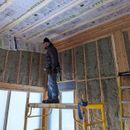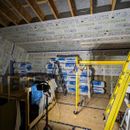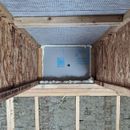Dense vs Loose Pack in Cathedral Unvented Ceiling
atburi
| Posted in Energy Efficiency and Durability on
Hi everyone,
I’m in the process of applying blow-in cellulose to our unvented cathedral ceiling in CZ 7. I want to extend a huge thank you to the GBA community for the wealth of articles, member insights, and comments that have been instrumental in guiding our project.
I have a specific question that I hope you can help with. Based on one of Martin’s comments, I understand that the primary goal of dense-packing is to achieve airtightness (and possibly to prevent sagging), rather than to maximize R-value. In fact, it seems there’s a density threshold beyond which the R-value actually decreases.
Considering our unvented ceiling’s current airtightness — with Solitex Mento
Plus on the exterior, Intello Plus on the interior, and spray foam at the box ends — I’m contemplating whether loose-filling the ceiling might be a feasible alternative to dense-packing. My reasoning is that loose-filling could potentially offer better R-value, while the existing membranes should maintain the necessary airtightness. This would also reduce the labour and skill required to apply the cellulose.
Plus on the exterior, Intello Plus on the interior, and spray foam at the box ends — I’m contemplating whether loose-filling the ceiling might be a feasible alternative to dense-packing. My reasoning is that loose-filling could potentially offer better R-value, while the existing membranes should maintain the necessary airtightness. This would also reduce the labour and skill required to apply the cellulose.
Eager to hear your thoughts: Is there a compelling reason to still aim for dense-packing to the recommended 3.5+ lbs. per cubic foot?
Perhaps it’s worth noting that the north slope of the roof is 16″ TJIs placed 24″ OC and the south slope is 16″ TJIs placed 16″ OC.
Thanks,
Alex
Alex
GBA Detail Library
A collection of one thousand construction details organized by climate and house part
Search and download construction details














Replies
The pitch will make a big difference. It looks to be a low pitch. You don't want the cellulose to roll down hill, but I do think you are right that you can get away with slightly less dense packing.
Do you have ventilation above the Mento?
Hi Tim,
Good to hear that I might be thinking about this the right way. You're correct that it's a low pitch (about 3:12) and there's 3" of ventilation above the Mento (2 layers of 2x strapping, no sheathing). One reason for more density would be to avoid slippage or settling of the cellulose but not sure how much of a concern that is on such a low slope.
I think you need to follow dense-packing techniques; loose-blowing as you would in an attic doesn't work against the air pressure in an enclosed cavity like yours. You shouldn't have much if any slippage at that slope. I would be most concerned about getting the eave and ridge areas fully packed. I would go for a full dense-pack in those areas and the rest could be on the light side. In my experience, very few installers get full density with rafter bays anyway; the techniques they're used to for 6" walls aren't enough for a full dense-pack in 12"+ bays.
Here is a graph I made several years ago to compare density and R-value. I used some placeholder values to get a smooth-ish curve but I checked my approach and results with a couple of building science experts and they thought it was reasonable.
Hi Michael, sounds like a good idea to dense-pack the ends of the bays, if just to add some extra air tightness. In your graph, are densities of +5 lbs/cubic foot ever reached? But yeah, looks like R-value drops off as discussed.
No, where I used to work doing panelized Passive Houses we aimed for 4.25 pcf but I've never seen anyone else attempt that. The idea with the graph is that if you keep compressing it, eventually you'll recreate softwood, and then hardwood. I was just trying to make a reasonably smooth curve to see what would happen to the R-value at 4.25 pcf as nobody tests for that density.
Got it :)
Hoping to piggyback on this question with one of my own: How does DIY dense packing of cellulose compare with dense packing timberfill? I have a sarking membrane vented roof 3/12 vaulted and would be concerned with compressing the venting channel.
I don't know that anyone has much experience with Timberfill yet, it's very new to the market. I'd be curious to hear how it goes though! It will probably be a bit before it's economical here in the Midwest due to shipping.
Stephen, the installed density and other characteristics are similar to cellulose so I don't see how it would be much different in terms of compressing your vent channel. How deep is your vent channel? I would at least 1 1/2" material, or 5/4 if going with cross-strapping and metal roofing, and stretch the membrane as tight as you can get it.
Michael, my vent channel is 1.5 inches and I wiil use pro clima mento as you suggest. I feel like I can get it tight. Would love to do timberfill if the cost comparison with cellulose was favorable. My ceiling depth, after dropping gussets, should be around 17 inches. Considering the DIY approach but its a long way off, so the budget will likely decide....I plan on doing 2x4 sleepers on top of the mento, 5/8 zip and a metal roof flat on the deck. I wasn't going to cross strap as the sales folks say its optional. Do you recommend ?